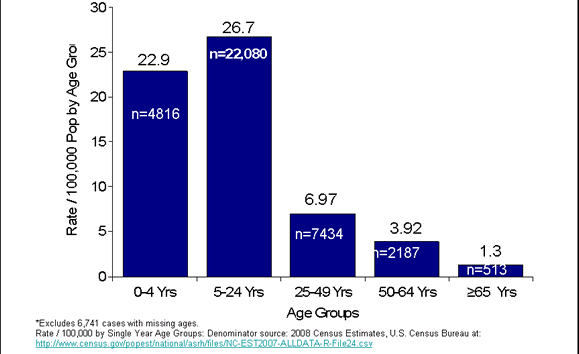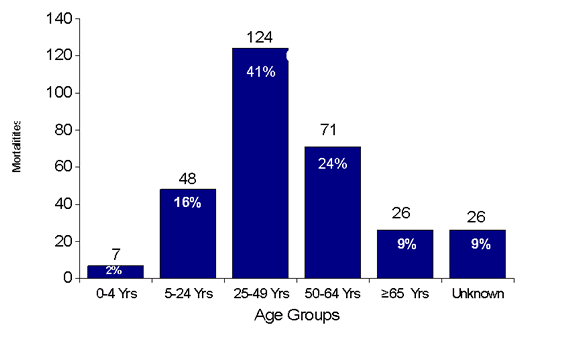fenerit wrote:Virus aren't stupid, this age is the age of "kisses" and sexual intercourses, so they infect better.
I don't think Massimo's somewhat simplistic "sexual interaction" theory is the right interpretation. What is unfortunately missing for comparison is the analogous distribution for the familiar
seasonal flu. Yet, I know that it looks qualitatively different. There, mainly the small kids and the seniors are getting it, reflecting the fact that
their immune system is weakest. Of course, young grown-ups or adolescents are
more actively involved in many "busy" aspects of life (eating in cantines or downtown bars, schools, universities, disco life, travelling abroad,...). These two main factors compete and -- also depending on the aggressiveness of the respective flu type -- will affect the age distribution.
Here is the analogous age distribution for US citizens:

(Data from CDC,
http://www.cdc.gov/h1n1flu/surveillanceqa.htm)
While the remarkable depletion of incidences among old-age people agrees with the data from Germany above, the US data show a much higher incidence for small children (0-4 yrs)!
As to the
striking old-age depletion pattern, one (unconfirmed) speculation is a partial immunisation due to some earlier H1N1 pandemic (where the young population was not yet born)...
Note that the age distribution of Swine flu
deaths matches qualitatively the pattern of the incidence distribution. That is particularly surprising for the old-age end, since older people are generally weaker in many respects...

(Data from CDC,
http://www.cdc.gov/h1n1flu/surveillanceqa.htm)
Again, it's
people from a similar young age group who constitute the dominant number of fatalities! This is another evidence against Massimo's "sexual intercourse" speculation...
Another possibility for explaining the old-age depletion was investigated quantitatively in Germany: perhaps the reason is that the virus has not yet been sufficiently introduced in this older-age sub-population (> 60 years). However, there is convincing evidence against this explanation from this plot (Germany, RKI)

When looking at the proportion of affected age groups over weeks, no shift towards the older (>60 years) or younger (<5 years) age groups can be seen (yet). Hence the striking age-dependent pattern rather appears to be related to different levels of immunisation!
Fridger





